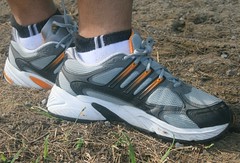Have a look at the following figure:

A particular enzyme molecule has an active site which is usually complimentary to the shape of the substrate on which it acts on. Hence enzyme's specificity. Meaning, a particular enzyme can only act on a particular substrate but not with other substrates.
At temperature higher than the optimum temperature, the shape of the active site of an enzyme starts to become distorted making it difficult for the substrate molecule to fit in into it. We say that after the optimum temperature, the enzyme starts to denature. Because of this chances for the enzyme molecules and the substrate molecules to collide to form enzyme-substrate complexes are now becoming lower and lower despite the availability of more kinetic energy at higher temperature. This in turn, causes less products to be formed. Hence the rate of reaction becomes lower and lower at temperatures higher than the optimum temperature.
At extremely high temperature the active site of an enzyme is said to be totally DENATURED. This means that the active site is actually totally distorted. As a result, substrate molecule finds it difficult to fit in into the active site. No enzyme-substrate complexes formed. Meaning, no products formed. This in turn means no reaction occurs. Hence the rate of reaction is actually NIL at this temperature.
Is this REVERSIBLE?
Absolutely NOT reversible. Once an enzyme is denatured, it is actually damaged and cannot be used again even if one tries to lower back the temperature to the optimum temperature.
How about at extremely low temperature?
Enzyme is not DENATURED at a very low temperature. It is simply INACTIVATED. This means there is no kinetic energy available at this temperature to activate the enzyme. Once the temperature is increased, kinetic energy will start to become available and the enzyme and substrate molecules will start to collide with each other to form enzyme-substrate complexes which will eventually break/combine to form products. [Break if the reaction is a CATABOLIC reaction (as shown in the figure above)and Combine if the reaction is an ANABOLIC reaction]
HAPPY READING PEOPLE!!!

A particular enzyme molecule has an active site which is usually complimentary to the shape of the substrate on which it acts on. Hence enzyme's specificity. Meaning, a particular enzyme can only act on a particular substrate but not with other substrates.
At temperature higher than the optimum temperature, the shape of the active site of an enzyme starts to become distorted making it difficult for the substrate molecule to fit in into it. We say that after the optimum temperature, the enzyme starts to denature. Because of this chances for the enzyme molecules and the substrate molecules to collide to form enzyme-substrate complexes are now becoming lower and lower despite the availability of more kinetic energy at higher temperature. This in turn, causes less products to be formed. Hence the rate of reaction becomes lower and lower at temperatures higher than the optimum temperature.
At extremely high temperature the active site of an enzyme is said to be totally DENATURED. This means that the active site is actually totally distorted. As a result, substrate molecule finds it difficult to fit in into the active site. No enzyme-substrate complexes formed. Meaning, no products formed. This in turn means no reaction occurs. Hence the rate of reaction is actually NIL at this temperature.
Is this REVERSIBLE?
Absolutely NOT reversible. Once an enzyme is denatured, it is actually damaged and cannot be used again even if one tries to lower back the temperature to the optimum temperature.
How about at extremely low temperature?
Enzyme is not DENATURED at a very low temperature. It is simply INACTIVATED. This means there is no kinetic energy available at this temperature to activate the enzyme. Once the temperature is increased, kinetic energy will start to become available and the enzyme and substrate molecules will start to collide with each other to form enzyme-substrate complexes which will eventually break/combine to form products. [Break if the reaction is a CATABOLIC reaction (as shown in the figure above)and Combine if the reaction is an ANABOLIC reaction]
HAPPY READING PEOPLE!!!







